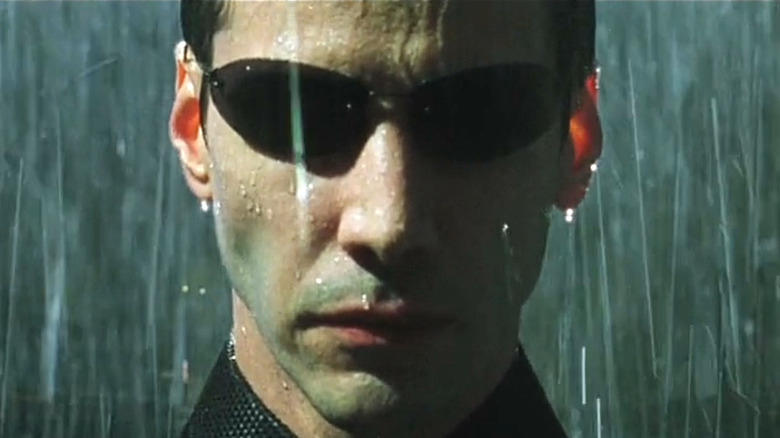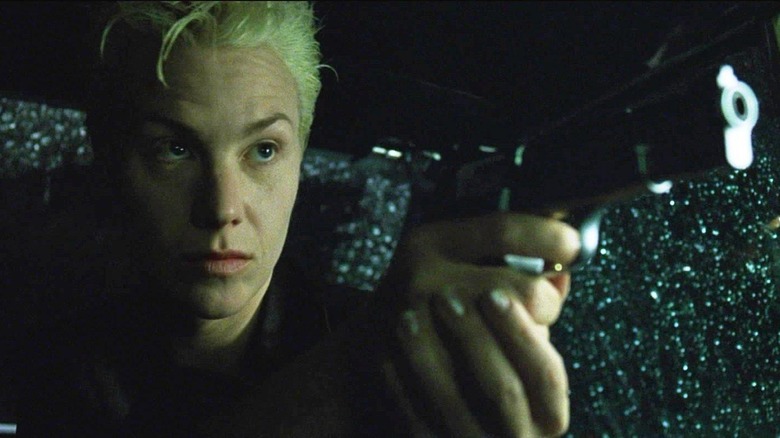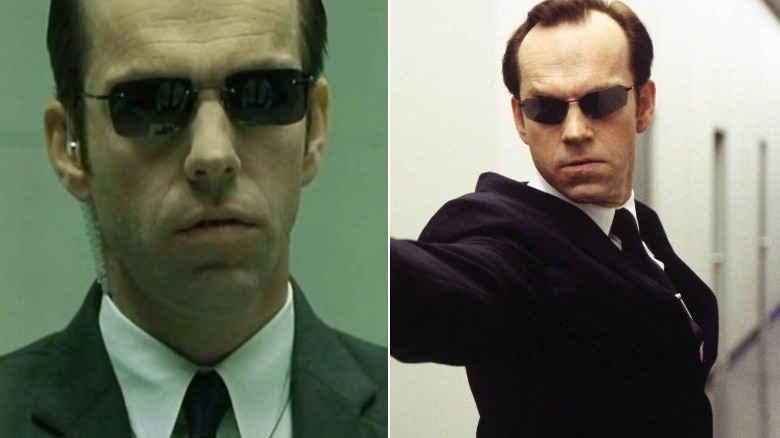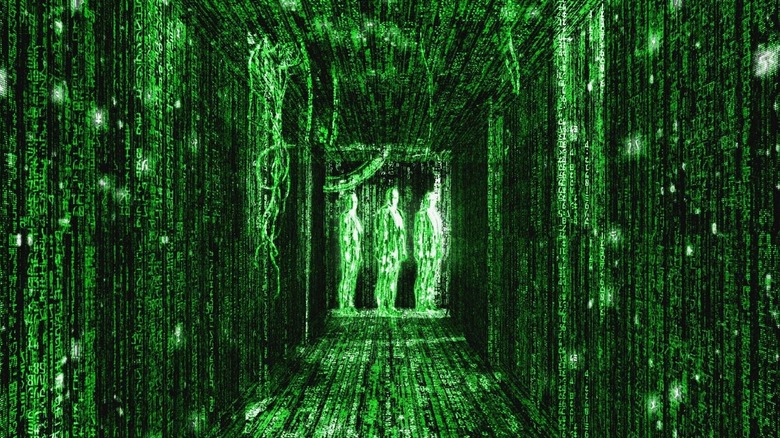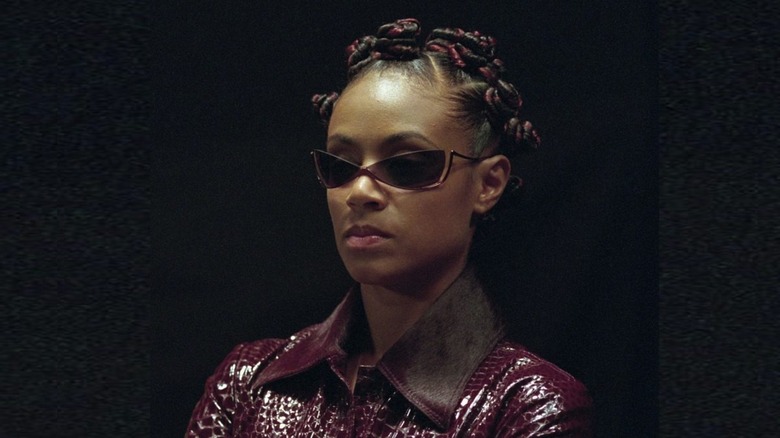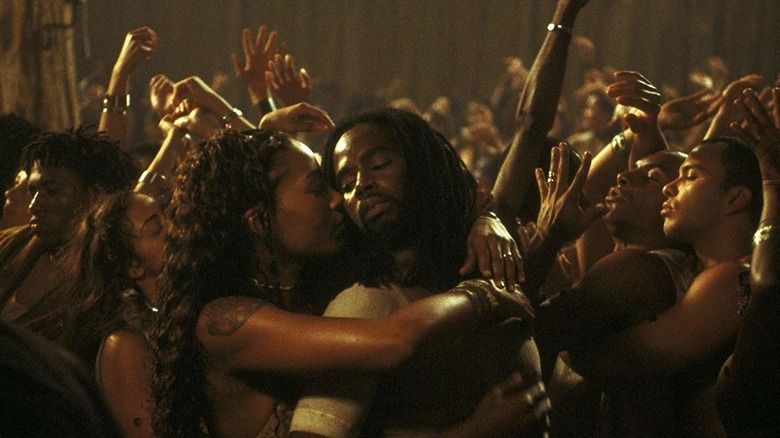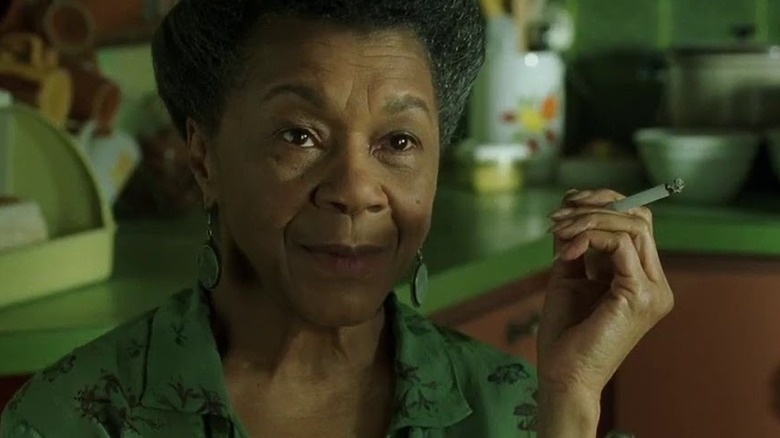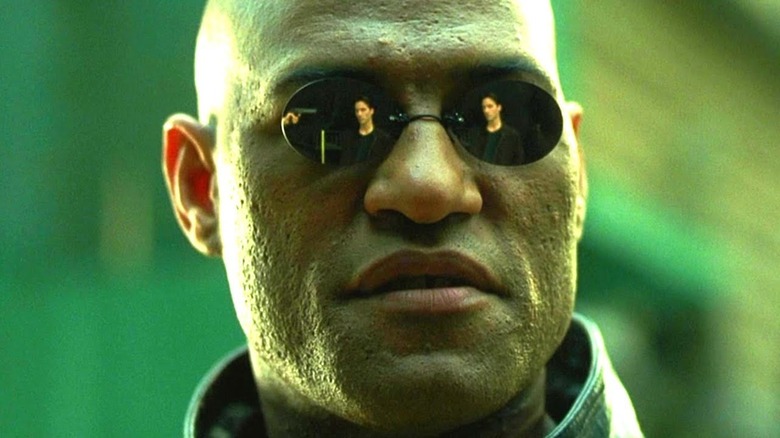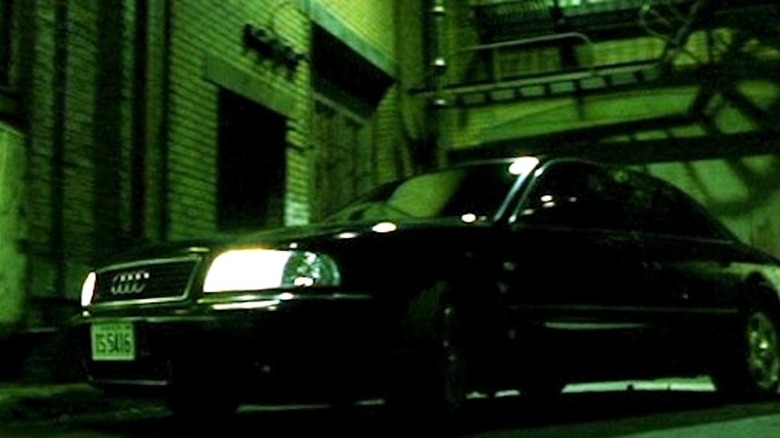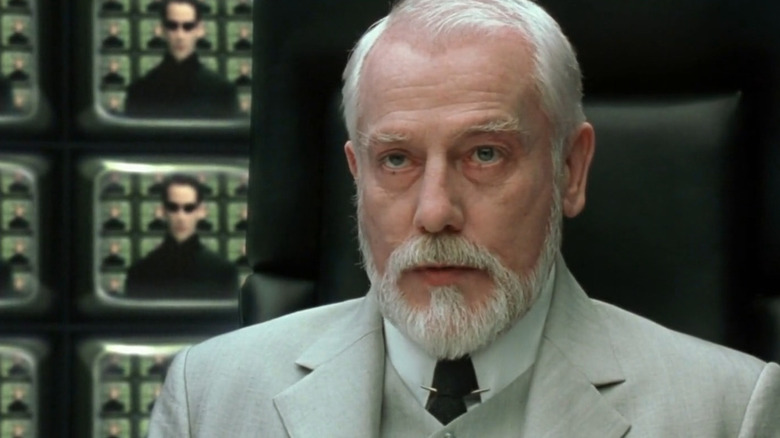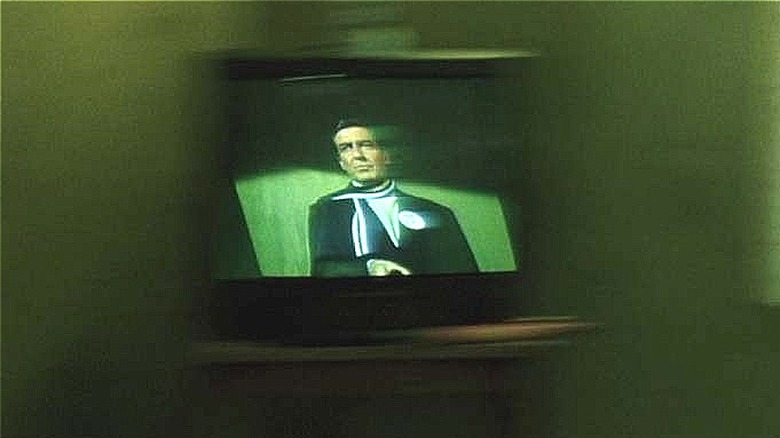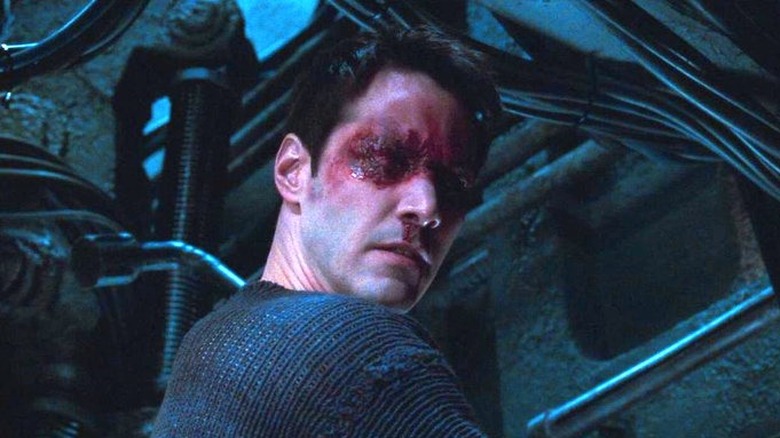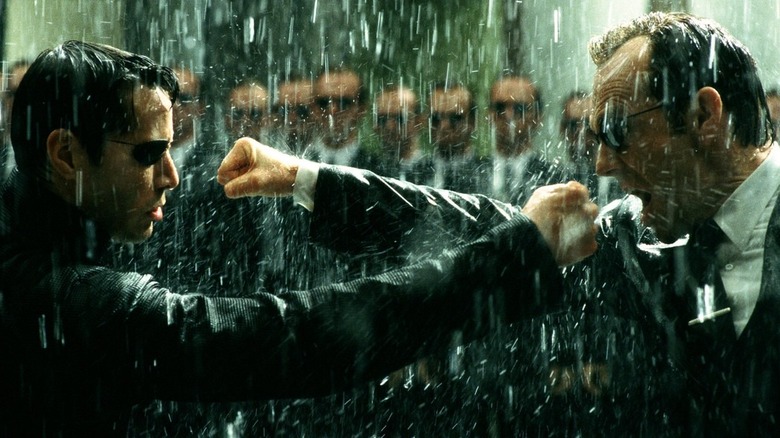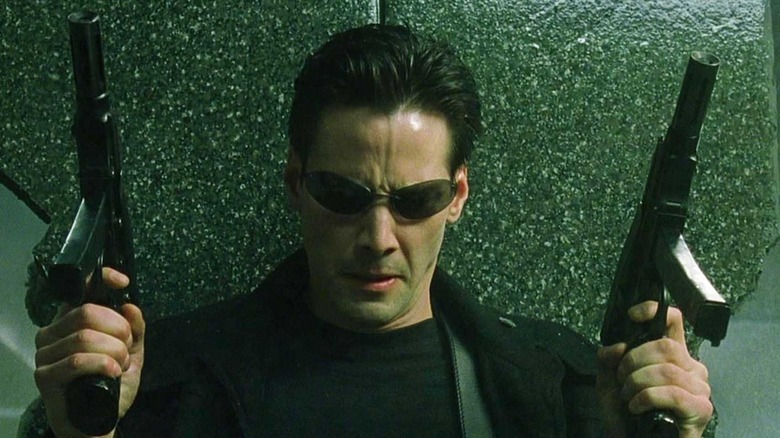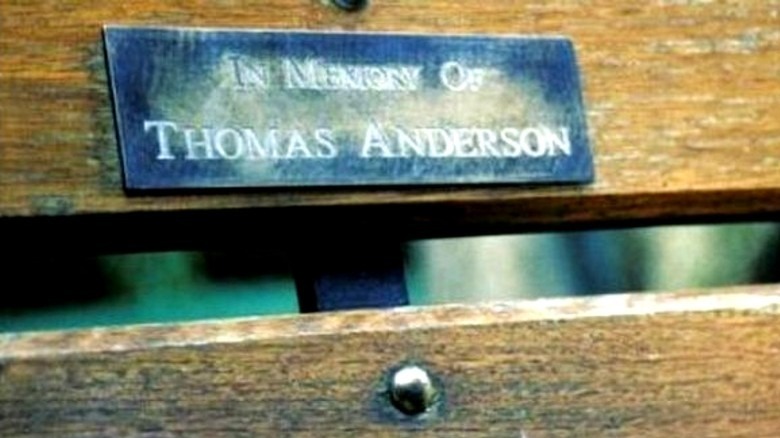Things You Only Notice About The Matrix After Rewatching The Series
The original "Matrix" trilogy is one of the most influential science fiction works of the modern era. It's a complex, layered story filled with hidden meanings, metaphors, subtle details, foreshadowing, allusion, and of course, loads upon loads of slo-mo action. While not all "Matrix" films are viewed as equals (1999's original film has a RottenTomatoes critic score of 88%, while 2003's "The Matrix Revolutions" falls all the way to 35%), each entry in the trilogy has its own unique flavor, making significant additions to the overall world.
Because "The Matrix" is a story built on mysteries and twists, there are many moments throughout the original trilogy whose full meanings aren't entirely clear the first time through. Events and characters are teased in ways that won't make sense for first-time viewers, character arcs are explored through subtle details, and even the most miniscule aspects of the films can include hidden significance.
The franchise's central premise of digital technology gone wrong is more relevant than ever in today's world, and with a new film on the way, it's the perfect time to revisit the franchise through a modern, retrospective lens. Here are some of the things you only notice about the "Matrix" trilogy after going back for a rewatch.
The Matrix Has A Ton Of Gender Allegory
When the first "Matrix" premiered in 1999, most of the analysis surrounding it involved themes of technological dependency, freedom, and control. While those are undeniably huge parts of the overarching "Matrix" story, going back and rewatching the trilogy, there's also a lot of subtle, perhaps ahead-of-its-time commentary made on gender identity and expression. In a 2020 interview, series co-creator/co-director Lilly Wachowski said a lot of the core "Matrix" story was an intentional allegory for the experience of trans people. As trans filmmakers, Lilly and her sister Lana found it important to explore ideas of gender identity and expression, though those themes have emerged predominantly in more modern interpretations of the franchise.
One instance of trans allegory in "The Matrix" is the character Switch in the original film, who is part of the crew aboard the Nebuchadnezzar. As alluded to by their name, Switch was initially written to be male in the real world and female in the Matrix, showing that their true self-image manifested differently in the digital world than the body they were born with. That version of the character was ultimately changed, but the Wachowskis kept Switch very androgynous and fluid in their gender expression. A huge part of the "Matrix" story is about transformation and finding your true self, which applies directly to ideas of gender identity and expression.
Smith Has A Wardrobe Change In The Matrix Reloaded
After being accidentally transformed by Neo at the end of "The Matrix," Agent Smith comes back more dangerous than ever in "Reloaded," freed from the confines of the system and imbued with enhanced powers of assimilation. One detail that's easily missed, however, is that Smith also changes his physical look between the two movies. His stark black "Reloaded" suit is subtly different from the more sickly gray of the first film — the color worn by all the normal agents — which shows how Smith has distanced himself from the other programs. His now-curved-at-the-bottom-edges sunglasses are also a slightly different style.
Even Smith's mannerisms are altered in minor but important ways in "The Matrix Reloaded." While he shows some instances of dry humor in the first film, his demeanor is much more aggressive and harsh, befitting the cold logic and accuracy the agents are designed to exhibit. After his life-changing encounter with Neo, however, he takes on a far more wry, sardonic tone, cracking jokes and talking trash while going up against Neo and his allies. These changes may seem small, but they all help push Smith farther away from his formulaic origins and towards the chaotic, destructive force he ultimately becomes.
The Matrix Music Is More Important Than It Seems
While the soundtrack to "The Matrix" is impressive on first listen, it grows even more complex and powerful the more you hear it. It's so complicated, in fact, that there's a whole dissertation on its many nuances and meanings, written by music philosophy scholar Christopher James Heckman. For those who lack the time, knowledge of music theory necessary to go through that very in-depth analysis, YouTube creator Sideways has an excellent video summing up some of the key points.
To be brief, composer Don Davis packs a ton of hidden meaning and symbolism into his scores for the original "Matrix" trilogy. He uses mechanical instrumentation for themes tied to the machine world, and choral music for themes tied to humanity. He crafts leitmotifs for different characters and relationships that grow in complexity throughout the series. He even uses a musical matrix — a complicated tool used in certain kinds of compositions — as a foundation for the overall score.
There are countless other fun details hidden in the "Matrix" score, like how the chorus backing Neo and Smith's final battle is actually singing a Sanskrit mantra from the Upanishads about finding truth, and how the opening theme of each film is set in a different, progressive key — E, then F#, then G. Obviously, many of those Easter eggs are never picked up on by most viewers, even upon multiple rewatches, but they all add to the thematic complexity of the franchise in fun, subconscious ways.
The Matrix Was Ahead Of Its Time In Its Diverse Casting
One of the more positive trends in modern Hollywood is a push towards better representation across the board in terms of race, gender, age, religion — really, any aspect of identity. That doesn't just mean calls for more nonwhite actors and strong female characters, but an allowance for all types of people to play all types of roles, rather than simply being typecast along the guidelines of regressive tropes and clichés. For a franchise that started in 1999, "The Matrix ” was clearly ahead of its time in this regard, and that becomes exceedingly apparent when rewatching the series today.
The three lead characters in "The Matrix" are a woman, a Black man, and an Asian man. People of color are everywhere in the human power structures of "The Matrix," representing the most skilled pilots (Jada Pinkett Smith's Niobe), the bravest military commanders (Nathaniel Lees' Captain Mifune), the most brilliant tacticians (Harry Lennix's Commander Lock), and the most skilled operators (Harold Perrineau's Link). Two women — Nona Gaye's Zee and Rachel Blackman's Charra — play important roles in the Battle of Zion. And that's all without mentioning characters like the Oracle, Seraph, Ghost, Sati, and others. Perhaps most importantly, "The Matrix" never reflects on these roles as exceptional. Instead, it imagines a world where someone's identity isn't even a consideration when discussing their skills, capabilities, and leadership.
The Rave Scene Really Isn't That Bad
Out of all the things in the "Matrix" sequels that get criticized by fans, the dance rave scene in "Reloaded" may be at the very top of the list. The backlash against the scene is understandable, as it stands in stark contrast to everything that happens in the story up until that point. However, when going back through the series, the rave scene feels more appropriate and less egregious than many have implied through the years.
"The Matrix" is, ultimately, a story about what it means to be human. The machine world acts as the standard against which humanity is measured. After the events of the first "Matrix" movie, none of which take place in Zion, "Reloaded" starts with an effort to show how, even in the post-apocalypse, humans are still finding uniquely human ways to thrive. The rave scene is an amalgamation of all the things that make humans human — dancing, laughing, singing, feasting, making love, and celebrating life with passion and vulnerability. It's a scene that shows what Neo, Trinity, and Morpheus are fighting for, establishing the stakes for the battles to come. Is it a little silly? Yes. But it's also a thematically important moment that fits better than it might seem with the overall story of the trilogy.
Agent Smith Is Terrified Of The Oracle
By "The Matrix Revolutions," Smith is by far the most powerful program in the Matrix. And yet, when he comes face-to-face with the Oracle, he's terrified. In the scene where Smith assimilates the Oracle, he's clearly nervous. He talks quickly and behaves erratically, trying to get her to admit why, knowing the future, she stayed where she was and allowed him to find her. The assimilation itself is the most difficult of any Smith undertakes, and it appears to be almost too much for him. Even when he succeeds, the other Smiths in the room look on the Oracle-Smith with fear, unsure whether or not he can be trusted.
Part of this may be due to the Oracle's reputation as an all-powerful program, but it may also have to do with her unique relationship with Smith. In the scene, he reveals that they've never met before, but later on he calls her "Mom." This mystery is never resolved, but given the role the Oracle ends up playing in Smith's demise, he's clearly right to fear her.
The Audience Feels What The Characters Feel
Having characters in a movie act as inserts for the audience is not a new idea, but "The Matrix" applies it in particularly clever, interesting ways. Obviously, the first film sets Neo in the same space as the viewer, figuring out the nature of the world he lives in as those watching the film are unravelling the mystery for themselves. Later on, Neo, Morpheus, and Trinity share the audience stand-in role as they learn that what they initially thought about the prophecy of The One isn't entirely accurate. They become disillusioned, Morpheus struggles with a loss of faith, and the characters aren't sure what to believe anymore.
Inadvertently, this disillusionment would mirror what many fans felt watching the "Matrix" sequels. The reception to "Reloaded" and "Revolutions" was far less positive than the original movie, largely because many of the truths of that film were either questioned or outright contradicted in the sequels. In a 2013 interview, Lana Wachowski said she and her sister were intentionally trying to create a mirror experience between the characters and the audience, making viewers experience the same loss of faith that Neo and Morpheus face. The end result is a fascinating experiment in combining form and narrative — an experiment that some viewers rejected, but which others praised for its complexity and emotional pull.
Smith Drives A Very Self-Aware Car
There are tons of hidden Easter eggs peppered through the "Matrix" trilogy, one involving Agent Smith's car in "The Matrix Reloaded." Eagle-eyed viewers may catch that the license plate on the Audi that Smith drives is "IS 5416" — a reference to the Book of Isaiah in the Bible. Isaiah 54:16, the 16th verse of the 54th chapter of the book, reads as follows in the King James translation: "Behold, I have created the smith that bloweth the coals in the fire, and that bringeth forth an instrument for his work; and I have created the waster to destroy."
Obviously, the Bible verse uses the word "smith" in reference to the profession — a blacksmith — but it fits perfectly onto the "Matrix" character as well, especially the bit about him being "the waster to destroy." Various myths and religious texts are referenced repeatedly throughout "The Matrix," but Smith's license plate is one allusion that most viewers will likely miss their first time through.
The Architect Is Foreshadowed In The Matrix Reloaded
Another hidden Biblical reference in "The Matrix Reloaded" involves the Keymaker and the Architect — two of the most important programs in the franchise. When explaining to Neo, Morpheus, and the rest of the gang how to reach the Source of the Matrix, the Keymaker says that they'll need to blackout 27 city blocks of electricity, and that Neo will then have a window of 314 seconds, or just over five minutes, to reach the mythical door. In the 27th book of the Bible's New Testament, Revelation — which is also the final book of the Bible — chapter 3, verse 14 (note, 27 and 314) reads as follows in the King James translation: "And unto the angel of the church of the Laodiceans write; these things saith the Amen, the faithful and true witness, the beginning of the creation of God."
This hidden piece of Biblical scripture foreshadows Neo's encounter with the Architect, the program that is essentially the god of the Matrix. It also alludes to the task Neo does not yet realize will be set before him in that encounter — resetting the Matrix for its next iteration, thereby once again returning to "the beginning of the creation."
The Matrix Keeps Referencing The Prisoner
Beyond myths and religious texts, "The Matrix" features other allusions to various books and works of art. For instance, "Alice in Wonderland" is used as a constant metaphor, especially in the first film. Another work that is alluded to multiple times in more subtle ways is the 1967 British sci-fi thriller "The Prisoner." That hugely influential show, which ran for only 17 episodes, told the story of a British intelligence operative kidnapped shortly after resigning his position and imprisoned in a mysterious village where he was repeatedly interrogated about certain sensitive information.
The first "Prisoner" reference in "The Matrix" takes place in the original film, when Neo is running from Agent Smith through a building. In one shot, he's shown standing by a TV that's playing an episode of "The Prisoner." Later, in "The Matrix Reloaded," Neo is informed by the Architect that he is the sixth incarnation of The One. In "The Prisoner," the main character is referred to in the village as Number Six. Because of the similarities between the two stories — both of which deal with imprisonment, mysterious oppressors, and quests for truth — it's clear that the Wachowskis have great respect for "The Prisoner."
Smith Accidentally Helps Neo Beat Him
In "The Matrix Revolutions," Agent Smith makes a fatal error dealing with Neo. Smith uses the body of Bane (the human whose mind he takes over to escape the Matrix) to attack Neo and Trinity while they're journeying to the Machine City. In the fight, Smith attacks Neo's eyes with an electrical cable, blinding him. However, that injury ends up working to Neo's advantage, as he's able to see the code of the machines and programs even more clearly than before. With this new advantage, he helps Trinity navigate through the city's defenses, enters the Matrix, and defeats Smith once and for all.
The level to which Neo's physical blindness actually enhances his powers is unclear, but it's certain that his sight wouldn't have helped him much on the last leg of his journey. Maybe if Smith had simply had the patience to wait, Neo wouldn't have made it to the Machine City alive, or maybe he would have been less attuned in their final battle. But Smith is an aggressive, egotistical villain, and he instead decides to attack Neo and Trinity preemptively, resulting in a wound that may have actually helped bring about the former agent's ultimate downfall.
The Matrix Is Visibly Collapsing In The Final Battle
As Neo and Smith engage in a climactic duel at the end of "The Matrix Revolutions," they're surrounded by a torrential downpour of rain. However, many of the falling droplets on screen aren't water at all, but rather individual lines of the Matrix code seen frequently throughout the trilogy. The implication is that the Matrix is literally falling apart as the battle rages, as a result of Smith's assimilation of the system and his efforts to eradicate the virtual world. It's a cool effect that's easy to miss, adding a fun extra layer to the final battle of the trilogy.
There are several other instances of code-like imagery throughout the "Matrix" trilogy, such as rain in different scenes of the first two films, and even soap suds in a window-washing shot of the original "Matrix." All of these moments help subtly drive home the artificial nature of the cyber world, establishing a strong tone and sprinkling a consistent symbolism from the beginning to the end, when the rain stops being merely representative of the code and literally becomes the numbers themselves.
Neo Saves Zion Twice
By beating Smith in the Matrix, Neo brokers a peace between humanity and the machines, saving Zion from destruction. However, he actually saves the city twice.
Earlier in "The Matrix Revolutions," when the human city is being attacked by the Sentinels, Captain Mifune attempts to open one of the gates so that Niobe and Morpheus can fly in and detonate their EMP. However, Mifune is killed before he can get the gate open, leaving the job in the hands of Kid — a young Zion soldier rescued from the Matrix by Neo. Through sheer bravery and force of will, Kid is able to open the gate just in time, allowing Niobe and Morpheus to detonate their EMP and buy enough time for Neo to reach the Machine City. Without that extra time, Zion would have likely fallen before he ever arrived.
Though indirectly, this first (temporary) rescue of Zion is thanks to Neo. He not only saved Kid from the Matrix, but he also inadvertently became the young man's hero. Kid idolizes Neo in "Reloaded" and "Revolutions," and that faith and admiration gives him the courage necessary to get the gate open. Neo saves Zion once through Kid, and again later by defeating Agent Smith.
Neo is Honored Within The Matrix
The final scene of the original "Matrix" trilogy shows the Architect meeting the Oracle on a park bench in the new version of the Matrix. The two ancient programs discuss the end of the war, the tenuous peace between the humans and the machines, and the impact of Neo on both groups. It's a nice full-circle moment to end the story on, but it has a bittersweet Easter egg that adds an extra layer of significance to the scene.
On the bench where the Oracle is sitting in the scene, there's a worn plaque that reads "In Memory of Thomas Anderson." That's Neo's name within the Matrix — the one that Smith continues to call him by throughout the series. Neo's fate at the end of the original trilogy is left a bit unclear, and it remained so until the announcement of "The Matrix Resurrections." Still, the plaque is a nice nod to what Neo did for both humans and machines — and a confirmation that the programs Smith was trying to destroy were grateful for Neo's efforts to save them.
